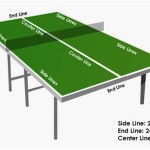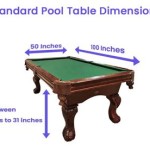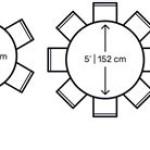6-Seat Kitchen Table Dimensions: A Comprehensive Guide
Selecting the appropriate size for a 6-seat kitchen table is crucial for ensuring both functionality and aesthetic appeal within a dining space. Dimensions significantly influence the comfort of diners, the flow of traffic around the table, and the overall visual harmony of the kitchen or dining area. Understanding the standard dimensions, factors influencing size selection, and common variations enables a more informed decision when purchasing or designing a 6-seat kitchen table.
The primary consideration in determining the ideal dimensions revolves around providing adequate space for each person to eat comfortably while also allowing for serving dishes and other table necessities. Beyond this functional aspect, the table's dimensions must harmonize with the size and layout of the surrounding room, avoiding a cramped or visually unbalanced appearance. This article provides a detailed exploration of 6-seat kitchen table dimensions, offering guidance on optimizing space and enhancing the dining experience.
Standard Dimensions for 6-Seat Kitchen Tables
While variations exist, typical dimensions for a 6-seat kitchen table provide a solid starting point for selection. These dimensions are generally designed to accommodate six adults comfortably, allowing for adequate elbow room and leg space.
For a rectangular table, the standard dimensions often fall within a range of 60 to 72 inches in length and 36 to 40 inches in width. These dimensions offer a sufficient surface area for place settings, serving dishes, and centerpieces without feeling overcrowded. The length allows three people to comfortably sit on each side, while the width provides ample space between diners across the table.
Round tables designed for six people typically have a diameter ranging from 48 to 60 inches. The circular shape promotes conversation and creates a more intimate dining experience. However, it's important to note that while a round table fosters social interaction, it might offer slightly less surface area than a rectangular table of comparable dimensions. The actual usable space can be reduced depending on the base design and the style of chairs used.
Square tables designed to seat six are less common but can work well in square-shaped rooms. The standard dimensions are usually between 48 and 54 inches per side. This configuration offers a more balanced and symmetrical look but might require slightly more overall floor space than a rectangular or round table.
Beyond the tabletop dimensions, the height of the table is also a critical factor. Standard table height is typically around 30 inches. This height allows for comfortable legroom for most adults when using standard dining chairs. Lower or higher tables may require custom-designed chairs to ensure a comfortable dining posture.
Factors Influencing Size Selection
Several factors beyond the standard dimensions should influence the selection of a 6-seat kitchen table. These considerations ensure the table seamlessly integrates into the existing space and fulfills the specific needs of the household.
The size of the room is perhaps the most significant consideration. Before purchasing a table, accurately measure the available space, accounting for walkways and other furniture. A table that is too large can make the room feel cramped and difficult to navigate. As a general rule, allow at least 36 inches of clearance between the edge of the table and any walls or other furniture. This clearance allows diners to easily pull out their chairs and move around the table without obstruction.
The shape of the room also plays a crucial role. Rectangular tables are often well-suited for rectangular rooms, as they complement the room's lines and maximize space utilization. Round tables can soften the appearance of a square room, while square tables can enhance the symmetry of a square space. Consider the existing architectural features and furniture placement to determine the most harmonious table shape.
The style of dining chairs selected should also be considered when determining the table size. Chairs with arms typically require more space than armless chairs. If you plan on using chairs with arms, factor in the extra width needed to accommodate them comfortably. Ensure that the chairs can be easily tucked under the table when not in use to maximize floor space.
The intended purpose of the table impacts the ideal dimensions. If the table will primarily be used for dining, the standard dimensions mentioned earlier will likely suffice. However, if the table will also serve as a workspace, a larger surface area may be necessary to accommodate laptops, papers, and other work-related items. In this case, a rectangular table with a longer length might be the most suitable choice.
Consider also the number of people who regularly use the table. While the table is intended to seat six, if it is frequently used by only two or three people, a smaller table might be more appropriate. Conversely, if the table is occasionally used to accommodate more than six people, consider a table with leaves or extensions that can be added when needed.
Common Variations and Space-Saving Solutions
Recognizing the standard dimensions provides a foundation, but various options cater to specific space constraints or aesthetic preferences. Exploring these variations can lead to a more tailored and effective solution.
Drop-leaf tables offer flexibility in smaller spaces. These tables feature hinged leaves that can be folded down when not needed, reducing the overall footprint of the table. When more space is required, the leaves can be raised, providing seating for six or more people. This type of table is ideal for apartments or homes with limited dining space.
Extension tables, similar to drop-leaf tables, can be expanded as needed. These tables typically have one or more leaves that can be inserted into the center of the table, increasing its length. Extension tables are a practical option for those who frequently entertain guests but do not require a large table on a daily basis.
Booth seating can be an alternative to traditional dining chairs. Booth seating can be custom-built or purchased as prefabricated units. When integrated with a table, they can offer a space-saving solution by eliminating the need for chairs on one or two sides of the table. Booth seating can also create a cozy and inviting dining atmosphere.
Consider the base design of the table. Pedestal tables, which have a single central support, can offer more legroom than tables with four legs. However, pedestal tables may be less stable than tables with four legs, particularly if the tabletop is large. The base style influences not only aesthetics but also the practical experience of using the table.
In smaller kitchens or dining areas, consider integrating the table into existing kitchen islands or countertops. This can create a seamless transition between the cooking and dining areas, maximizing space utilization. A kitchen island with an extended countertop can function as both a workspace and a dining area, eliminating the need for a separate table altogether.
Corner banquette seating can make efficient use of otherwise underutilized corner space in a kitchen or dining area. A corner banquette typically consists of two benches arranged at a right angle, with a table positioned in front. This arrangement can comfortably seat six or more people and provides a cozy and intimate dining setting.
When space is particularly limited, consider a counter-height table with bar stools. Counter-height tables are typically around 36 inches tall, which is the same height as a standard kitchen countertop. This type of table can be integrated into a kitchen island or used as a stand-alone dining table. Bar stools are typically smaller than dining chairs, which can help to save space.
Finally, consider the material of the table. Glass-top tables can create the illusion of more space, as they allow light to pass through and do not block the view of the floor. However, glass-top tables may be more prone to scratches and require more frequent cleaning than tables made of wood or other materials. Lighter colored woods can also help to make a room feel brighter and more spacious.
What Size Dining Table Seats 6 Quora
What Is A Suggested 6 Seater Dining Table For Your Home Quora

Explore The Versatility Of Rectangle Tables For Dining

6 Seater Dining Table Dimensions Furdir Tavolo Tondo In Resina Arredamento
What Is A Suggested 6 Seater Dining Table For Your Home Quora

Pin By Oana Tiution On Dinning Room Dining Table Sizes 12 Person 6 Seater

What Is The Standard Size Of A 6 Seater Dining Table Fabuliv Blogs 2024

Dimensions 5x3 Feet Brown 6 Seater Wooden Dining Table At Rs 30000 Piece In Tiruchirappalli

Dining Table Guide Size Shape Seating Sizes Round

Buy Ingrid 6 Seater Dining Table In Walnut Godrej Interio
Related Posts








